After His baptism in the River Jordan, Jesus began His public ministry by inviting John and Andrew to “come and see” where He was staying (John 1:39). The next day, Jesus called Phillip, who in
turn invited Nathanial to “come and see” “him of whom Moses in the law and also the prophets wrote, Jesus of Nazareth, the son of Joseph” (John 1:45). Recently, I, too, had an opportunity to “come and see,” as a pilgrim to the Holy Land. It was a transformative experience, one in which I truly felt as if I personally met, and came to know, the Lord more intimately.
Christians in the West have just begun the liturgical season of Advent, while Christians in the East have been preparing for Christ’s nativity since November 15 with a 40 day fast, which providentially begins after the Feast of St. Phillip. I share my pilgrimage experiences of Bethlehem and the Basilica of the Nativity, in the hope that it might encourage the reader to enter this season of preparation more deeply. I invite the reader to prayerfully meet Jesus as Mary’s son, to recognize Him as God’s Word in human flesh, and to know Him more intimately as God Himself. I invite the reader to “come and see” …
But you, Bethlehem Ephratha, though you be little among the thousands of Judah, yet out of you shall come forth unto me the One that is to be ruler in Israel: whose goings forth have been from old, from everlasting. (Mic. 5:2)
Since the Old Testament, Bethlehem has been associated with “hesed” (Hebrew) or “elios” (Greek), which means loving-kindness or mercy. This is described in the story of Ruth, who in her loving kindness, traveled from Moab to Bethlehem with her mother in law, Naomi, whom Ruth helped care for. Ruth’s kindness was rewarded when she remarried to Boaz. They had a son, Obed, and
a grandson, Jesse, who would be the father of David and from whose genealogy would come the Savior, our Lord Jesus Christ. (Ruth 1-4)
Bethlehem, also originating from the Hebrew word “bet ˈleχem,” means “house of bread”. The Second Person of the Trinity, in His loving kindness and fidelity, took on flesh, and as the Living read entered the House of Bread to save this world.
Behold a New and Wondrous Mystery!
Today the Virgin gives birth to the Transcendent One, and the earth offers a cave to the Unapproachable One! Angels with shepherds glorify Him! The wise men journey with a star! Since for our sake the Eternal God was born as a Little Child! – Kontakion (Byzantine liturgical hymn) on the Feast of the Nativity of our Lord God and Savior Jesus Christ
 Day two of our pilgrimage began with celebrating Divine Liturgy in the Shepherds’ Cave. This cave, located in Shepherds’ Fields, is reserved for small group worship. The Gospel of Luke tells us it is here that an angel announced the birth of Jesus (Luke 2:8-10). Some sources say that the sheep bought for sacrifice in the Temple were raised in these fields. It is also said that the shepherds from this area were descendants of David, who having a pure heart, were worthy of hearing the angels sing.
Day two of our pilgrimage began with celebrating Divine Liturgy in the Shepherds’ Cave. This cave, located in Shepherds’ Fields, is reserved for small group worship. The Gospel of Luke tells us it is here that an angel announced the birth of Jesus (Luke 2:8-10). Some sources say that the sheep bought for sacrifice in the Temple were raised in these fields. It is also said that the shepherds from this area were descendants of David, who having a pure heart, were worthy of hearing the angels sing.
Sitting in this cave, I was filled with wonder. I imagined what it was like on that memorable night: looking up at the night sky, seeing the moon and stars; watching over the animals in the cave, being warmed by their presence on this cold night; the Angel of the Lord appearing and being surrounded by the glory of the Lord! I began to comprehend St. Irenaeus’ teaching, “Man is made fully alive in the glory of God!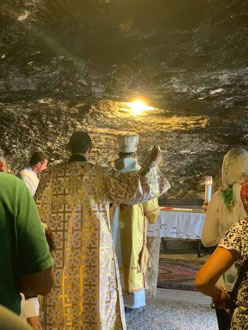
Eternal God born a child — I behold a strange and most glorious mystery, the Church sings with awe, Heaven, a Cave; the Virgin the Throne of the Cherubim; the Manger a room, in which Christ, the God Whom nothing can contain is laid.– Irmos of the 9th Ode of the Nativity Canon (Byzantine Nativity Divine Liturgy).
”the Word was made flesh and dwelt among us” (John 1:14)
Making our way through the town of Bethlehem toward the Basilica of the Nativity, I note the busy-ness of the streets and realize we are traversing on some of the very same stones that Joseph and Mary once walked. I consider the hardships of traveling over 100 miles in harsh, dangerous desert terrain; nine months pregnant, without a place to go…
At the time of our Savior, it was common for people to live in caves. Animals were kept in the lower cave, while an upper cave served as the living quarters. Joseph obtained permission to stay in
such a cave with the animals, and it was here that our Lord chose to be born.
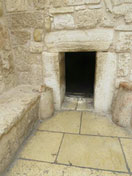 The only doorway in the fortress-like front wall of the Basilica of the Nativity is just 1.2 meters high. One has to stoop low to enter the basilica. The entrance was lowered around the year 1500 to stop looters from driving their horses and carts into the church. It seems appropriate to bow low before entering the place where God humbled himself to become man.
The only doorway in the fortress-like front wall of the Basilica of the Nativity is just 1.2 meters high. One has to stoop low to enter the basilica. The entrance was lowered around the year 1500 to stop looters from driving their horses and carts into the church. It seems appropriate to bow low before entering the place where God humbled himself to become man.
Straightening up on the other side of this doorway, one is greeted by a long nave and rows of tall Corinthian columns that direct one’s gaze toward a very elaborate iconostasis (icon screen). A very high vaulted ceiling supported by wooden rafters magnifies this sense of space. A tapestry of oil lamps and multi-colored globes hang from the ceiling, evoking a sense of mystery and other-worldliness. Networks of specially designed scaffolding line the walls and columns. Since being placed on UNESCO’s List of World Heritage in Danger, the Basilica of the Nativity has been undergoing extensive renovation and restoration, which is almost complete.
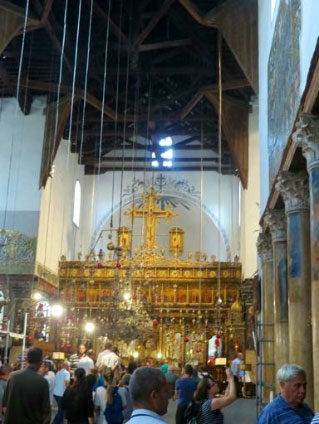
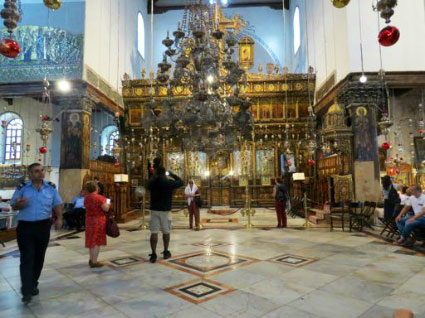
Interior of basilica
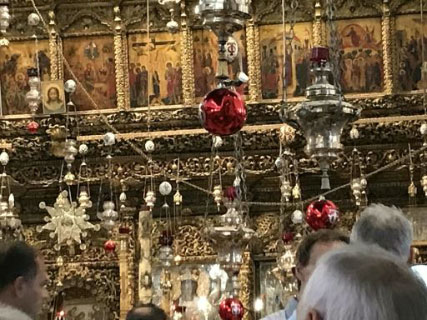

Part of restored mosaic and hanging oil lamps
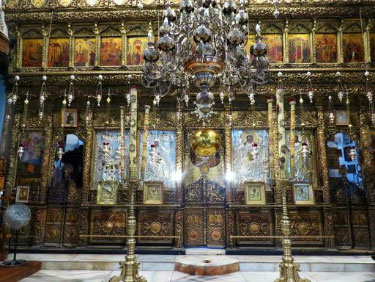 Iconostasis
Iconostasis
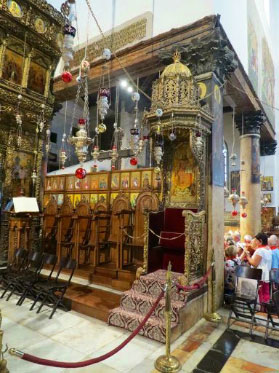
The main altar of the church is located behind the iconostasis, directly above the crypt or Grotto of the Nativity. To the right of the nave, pilgrims wait in a long line to visit this sacred site where Jesus was born. Before descending into the Holy Cave, one is able to pray before a very large icon of Our Lady of Bethlehem and light a candle for their prayer intentions. This icon is unusual in that Mary is smiling and appears joyful with her child despite the sorrows that are to come. Icons are typically stylized “windows to heaven” and without expression.
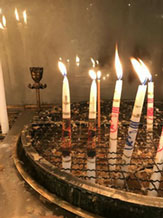
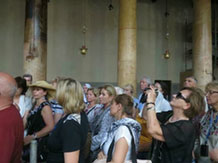
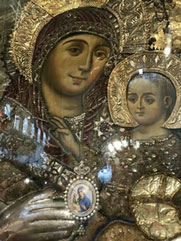

We make our way behind the altar to the steep stairs leading down to the grotto, anxious to kneel on sacred ground. The area where Jesus was born is marked by a 14-pointed silver star set into the
marble floor and surrounded by 15 silver lamps representing the three Christian communities responsible for maintaining the basilica. The Altar of the Nativity is maintained by the Greek Orthodox and Armenian Apostolic churches. Roman Catholics are in charge of a section of the Grotto known as the “Grotto of the Manger, “ the traditional site where Mary laid the newborn Baby in the manger.
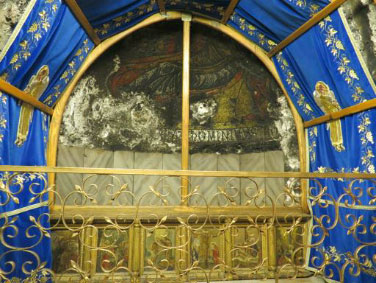
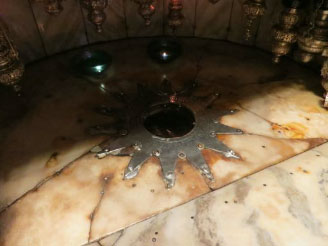
Altar above the star demarcating the site where Jesus was born.
After waiting in line for so long, the moment of veneration came and went so quickly. The pilgrim in me wanted to quietly linger. Thankfully, our group was allowed to wait in the grotto until
everyone had an opportunity to approach the sacred spot. Then, we all sang a medley of Christmas carols. At that moment, time and space transcended. I felt as if I was worshipping the Newborn King with the shepherds. The lamps and ornamental globes scattered throughout the Grotto, gifts to the Newborn King, made it seem as if I was adoring with the Magi. There was a sense of awe and wonder that this is indeed the spot where Heaven and Earth condescended in the form of a newborn baby boy. Such a divine love for human beings is incomprehensible and transcends every ability to explain.
“Heaven and earth join in celebration…Wise men and shepherds welcome Him…Angels and humans sing with joy… for God is with us!” – Hymn of laudation: “God is with us!”

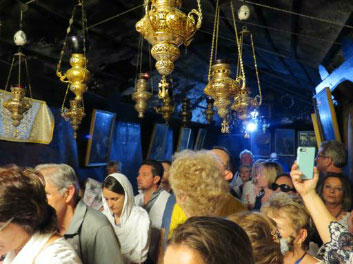
Throughout the Gospel, Jesus invites us to follow Him. But, it is not enough to just follow Christ. We must come and see. We must ask the Lord to open the eyes of our minds and hearts, so that
we may gain insight into the mystery of Christ, which is now made manifest through the Church.
Christ is Born! Glorify Him!
– written by Donna Dobrowolsky, M.D.[/column]
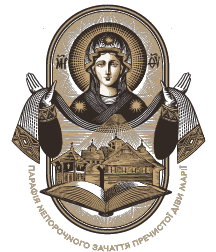


Write a comment: